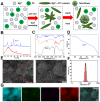Controlled-release hydrogel loaded with magnesium-based nanoflowers synergize immunomodulation and cartilage regeneration in tendon-bone healing
- PMID: 38440323
- PMCID: PMC10909705
- DOI: 10.1016/j.bioactmat.2024.02.024
Controlled-release hydrogel loaded with magnesium-based nanoflowers synergize immunomodulation and cartilage regeneration in tendon-bone healing
Abstract
Tendon-bone interface injuries pose a significant challenge in tissue regeneration, necessitating innovative approaches. Hydrogels with integrated supportive features and controlled release of therapeutic agents have emerged as promising candidates for the treatment of such injuries. In this study, we aimed to develop a temperature-sensitive composite hydrogel capable of providing sustained release of magnesium ions (Mg2+). We synthesized magnesium-Procyanidin coordinated metal polyphenol nanoparticles (Mg-PC) through a self-assembly process and integrated them into a two-component hydrogel. The hydrogel was composed of dopamine-modified hyaluronic acid (Dop-HA) and F127. To ensure controlled release and mitigate the "burst release" effect of Mg2+, we covalently crosslinked the Mg-PC nanoparticles through coordination bonds with the catechol moiety within the hydrogel. This crosslinking strategy extended the release window of Mg2+ concentrations for up to 56 days. The resulting hydrogel (Mg-PC@Dop-HA/F127) exhibited favorable properties, including injectability, thermosensitivity and shape adaptability, making it suitable for injection and adaptation to irregularly shaped supraspinatus implantation sites. Furthermore, the hydrogel sustained the release of Mg2+ and Procyanidins, which attracted mesenchymal stem and progenitor cells, alleviated inflammation, and promoted macrophage polarization towards the M2 phenotype. Additionally, it enhanced collagen synthesis and mineralization, facilitating the repair of the tendon-bone interface. By incorporating multilevel metal phenolic networks (MPN) to control ion release, these hybridized hydrogels can be customized for various biomedical applications.
Keywords: Controlled release; Immunomodulation; Magnesium; Metal–phenolic networks; Self-assembly process; Tendon-bone interface.
© 2024 The Authors.
Conflict of interest statement
The authors declared that they have no conflicts of interest to this work. We declare that we do not have any commercial or associative interest that represents a conflict of interest in connection with the work submitted.
Figures












Similar articles
-
Nanocomposite hydrogels stabilized by self-assembled multivalent bisphosphonate-magnesium nanoparticles mediate sustained release of magnesium ion and promote in-situ bone regeneration.Acta Biomater. 2017 Dec;64:389-400. doi: 10.1016/j.actbio.2017.09.039. Epub 2017 Sep 27. Acta Biomater. 2017. PMID: 28963020
-
Synergistic enhancement of tendon-to-bone healing via anti-inflammatory and pro-differentiation effects caused by sustained release of Mg2+/curcumin from injectable self-healing hydrogels.Theranostics. 2021 Apr 3;11(12):5911-5925. doi: 10.7150/thno.56266. eCollection 2021. Theranostics. 2021. PMID: 33897889 Free PMC article.
-
Dual-Targeted Metal Ion Network Hydrogel Scaffold for Promoting the Integrated Repair of Tendon-Bone Interfaces.ACS Appl Mater Interfaces. 2024 Feb 7;16(5):5582-5597. doi: 10.1021/acsami.3c16544. Epub 2024 Jan 23. ACS Appl Mater Interfaces. 2024. PMID: 38258503
-
Metal-phenolic network biointerface-mediated cell regulation for bone tissue regeneration.Mater Today Bio. 2024 Dec 12;30:101400. doi: 10.1016/j.mtbio.2024.101400. eCollection 2025 Feb. Mater Today Bio. 2024. PMID: 39759849 Free PMC article. Review.
-
The role of hydrogels in the management of brain tumours: a narrative review.Ann Med Surg (Lond). 2024 Feb 8;86(4):2004-2010. doi: 10.1097/MS9.0000000000001809. eCollection 2024 Apr. Ann Med Surg (Lond). 2024. PMID: 38576913 Free PMC article. Review.
Cited by
-
Polymeric Dural Biomaterials in Spinal Surgery: A Review.Gels. 2024 Sep 6;10(9):579. doi: 10.3390/gels10090579. Gels. 2024. PMID: 39330181 Free PMC article. Review.
-
3D-printed bioceramic scaffolds for bone defect repair: bone aging and immune regulation.Front Bioeng Biotechnol. 2025 Mar 31;13:1557203. doi: 10.3389/fbioe.2025.1557203. eCollection 2025. Front Bioeng Biotechnol. 2025. PMID: 40242352 Free PMC article. Review.
-
Thermosensitive Hydrogel Integrated with Bimetallic Nano-Enzymes for Modulating the Microenvironment in Diabetic Wound Beds.Adv Sci (Weinh). 2025 Feb;12(6):e2411575. doi: 10.1002/advs.202411575. Epub 2024 Dec 16. Adv Sci (Weinh). 2025. PMID: 39686701 Free PMC article.
-
Magnesium ions attenuate tendon graft fibrosis during its ligamentization after ACL reconstruction through modulation of fibroblast to myofibroblast trans-differentiation by promoting PGE2 secretion.Bioact Mater. 2025 Jun 17;52:474-491. doi: 10.1016/j.bioactmat.2025.06.019. eCollection 2025 Oct. Bioact Mater. 2025. PMID: 40599342 Free PMC article.
-
Bilayer book- like decellularized extracellular matrix scaffold with bioactive coatings for rotator cuff repair.Mater Today Bio. 2025 Jul 1;33:102038. doi: 10.1016/j.mtbio.2025.102038. eCollection 2025 Aug. Mater Today Bio. 2025. PMID: 40688655 Free PMC article.
References
-
- Atesok K., Doral M.N., Karlsson J., Egol K.A., Jazrawi L.M., Coelho P.G., Martinez A., Matsumoto T., Owens B.D., Ochi M., Hurwitz S.R., Atala A., Fu F.H., Lu H.H., Rodeo S.A. Multilayer scaffolds in orthopaedic tissue engineering. Knee Surg. Sports Traumatol. Arthrosc. J. ESSKA. 2016;24(7):2365–2373. doi: 10.1007/s00167-014-3453-z. - DOI - PubMed
LinkOut - more resources
Full Text Sources

